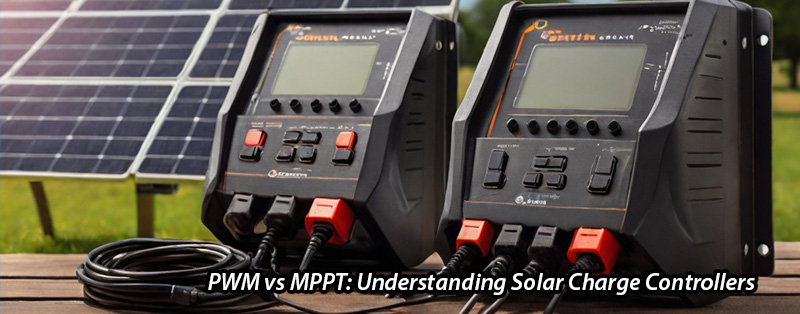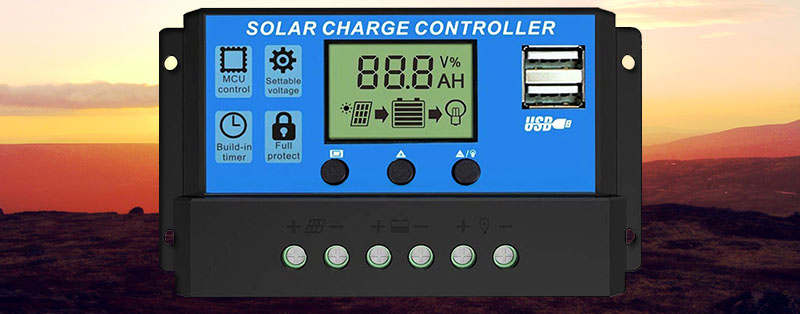Quick Introduction to different types of solar charge controllers and use cases
Solar energy is rapidly becoming a popular choice for powering homes, businesses, and other devices. However, harnessing this energy efficiently requires the use of solar charge controllers. These devices play a crucial role in regulating the flow of electricity from solar panels to batteries, ensuring optimal charging and preventing overcharging.

Two commonly used types of solar charge controllers are PWM (Pulse Width Modulation) and MPPT (Maximum Power Point Tracking). In this article, I will explain the differences between PWM and MPPT charge controllers, their advantages and disadvantages, and help you make the right choice for your solar energy system.
Understanding PWM (Pulse Width Modulation) solar charge controllers
PWM charge controllers are one of the oldest and most widely used types of solar charge controllers. They work by rapidly turning the solar panel’s output on and off, effectively controlling the amount of energy sent to the battery. PWM charge controllers are suitable for small-scale solar systems with lower voltage panels. They are cost-effective and relatively easy to install.

One of the advantages of PWM charge controllers is their simplicity. They have fewer components compared to MPPT controllers, making them more reliable and less prone to failure. Additionally, PWM charge controllers are generally less expensive than MPPT controllers, making them an attractive option for budget-conscious individuals.
However, PWM charge controllers have some limitations. Since they regulate the voltage by turning the panel’s output on and off, they are not as efficient as MPPT controllers. This means that in situations where the solar panel’s output is significantly higher than the battery voltage, PWM charge controllers will waste some of the available energy.
How PWM solar charge controllers work
PWM charge controllers operate by constantly monitoring the voltage of the battery and the solar panel’s output. When the battery reaches the desired voltage, the PWM controller will start to pulse the current, reducing the amount of energy reaching the battery. As the battery voltage drops, the PWM controller will increase the pulse width, allowing more energy to flow into the battery. This on-off cycling continues until the battery is fully charged.
Can I use a higher PV input voltage than the battery configuration ?
In most cases, it’s not advisable to connect solar panels with a higher voltage than the battery bank to a PWM (Pulse Width Modulation) solar charge controller.
Here’s why you should not connect solar panels with a higher voltage than the battery bank:
- Mismatched Voltage: When you connect a 48V solar panel to a 24V battery bank, the voltage difference can cause issues. The PWM charge controller regulates the voltage from the solar panels to charge the battery. With a 48V solar panel and a 24V battery bank, the controller may not be able to efficiently regulate the voltage, potentially leading to overcharging of the battery bank.
- Efficiency Loss: PWM charge controllers work by effectively switching the solar panel’s voltage on and off to regulate the charging of the battery. When the solar panel voltage is significantly higher than the battery bank voltage, there will be more energy loss in the regulation process, reducing overall efficiency.
- Potential Damage: Continuously exposing a lower voltage battery bank to a higher voltage solar panel can potentially damage the battery bank or the charge controller over time due to overcharging or other voltage-related issues.
A good practice when sizing PV on a PWM charge controller
To avoid these problems, it’s generally recommended to match the voltage of the solar panels to the voltage of the battery bank. For instance, using a 24V battery bank with 2 x 12 volt solar panels connected in series would be the best approach.
In addition, connect 1 x 12v solar panel or 2 x 12v solar panels in parallel when using a 12v battery bank, as long as you do not exceed the solar charge controllers maximum capable Ampere (current) or voltage and wattage ratings.
Alternatively, you could consider using an MPPT (Maximum Power Point Tracking) charge controller, which can handle higher voltage solar panels and step down the voltage to match the battery bank while maintaining higher efficiency compared to PWM controllers.
Understanding MPPT (Maximum Power Point Tracking) solar charge controllers
MPPT or Maximum Power Point Tracking charge controllers are a more advanced type of solar charge controller. They are designed to maximize the energy harvested from the solar panels by constantly tracking the maximum power point of the panel’s output.
This means that even in situations where the solar panel’s output voltage is higher than the battery voltage, an MPPT charge controller can efficiently convert and deliver the maximum amount of energy to the battery.
One of the key advantages of MPPT charge controllers is their high efficiency. They can convert and deliver up to 30% more energy compared to PWM charge controllers, making them an ideal choice for larger solar systems or situations with limited space for solar panels.
However, MPPT charge controllers are generally more expensive than PWM controllers, and their installation and setup can be more complex. Additionally, MPPT controllers may have more components, which can increase the risk of failure. It is important to carefully consider these factors when deciding which type of charge controller to use.
How MPPT solar charge controllers work
MPPT charge controllers use advanced algorithms and electronic components to constantly track the maximum power point of the solar panel’s output. They adjust the voltage and current to ensure that the solar panel operates at its maximum efficiency, regardless of the battery voltage. This allows for optimal energy conversion and efficient charging of the battery.
MPPT charge controllers also offer additional features such as monitoring and data logging capabilities, allowing users to track the performance of their solar system and make adjustments if necessary. These controllers are often equipped with advanced safety features to protect the battery and other components from overcharging and over discharging.
PWM vs MPPT: Key differences and similarities
While both PWM and MPPT charge controllers serve the same basic function of regulating the flow of electricity from solar panels to batteries, there are several key differences between them.
- Efficiency: MPPT charge controllers are significantly more efficient than PWM controllers, especially in situations where the solar panel’s output voltage exceeds the battery voltage. MPPT controllers can convert and deliver more energy to the battery, resulting in higher overall system efficiency.
- Cost: PWM charge controllers are generally less expensive than MPPT controllers. If you have a smaller solar system or are on a tight budget, a PWM controller may be a suitable choice. However, if you have a larger solar system or want to maximize energy harvesting, investing in an MPPT controller may be a better long-term investment.
- Complexity: PWM charge controllers are simpler and easier to install compared to MPPT controllers. MPPT controllers require additional wiring and may have more components, increasing the complexity of the installation process. If you have limited technical knowledge or prefer a more straightforward setup, a PWM controller may be the right choice.
- Flexibility: MPPT charge controllers are more flexible when it comes to connecting different types and configurations of solar panels. They can handle a wider range of input voltages and can be used with both higher and lower voltage panels. PWM controllers, on the other hand, are typically suitable for systems with lower voltage panels.
Factors to consider when choosing between PWM and MPPT solar charge controllers
When deciding between PWM and MPPT charge controllers, there are several factors to consider:
- System size: If you have a small-scale solar system with lower voltage panels, a PWM charge controller may be a cost-effective choice. However, if you have a larger system or plan to expand it in the future, an MPPT charge controller will provide better efficiency and energy harvesting capabilities.
- Budget: PWM charge controllers are generally less expensive than MPPT controllers. If you are on a tight budget, a PWM controller may be the more affordable option. However, if you can afford the extra cost, investing in an MPPT controller will result in higher energy savings over time.
- Space limitations: If you have limited space for solar panels and need to maximize the energy harvested, an MPPT charge controller is the better choice. Its ability to convert and deliver more energy will ensure that you make the most of the available space.
- Technical expertise: PWM charge controllers are simpler to install and require less technical knowledge compared to MPPT controllers. If you are a beginner or prefer a more straightforward setup, a PWM controller may be the right choice for you.
Conclusion: Making the right choice for your solar energy system
Choosing the right solar charge controller is crucial for optimizing the performance of your solar energy system. While PWM charge controllers are suitable for smaller systems and have the advantage of simplicity and affordability, MPPT charge controllers offer higher efficiency and flexibility for larger systems or situations with higher voltage panels. Carefully consider your system size, budget, space limitations, and technical expertise to make an informed decision.
Furthermore, if you have need for exceptional monitoring software we offer IoT Software. Visit Microfusion’s Solstus software. Our software can assist you in monitoring all Axpert type inverters and provide valuable insights for maximizing the efficiency of your solar energy system. Embrace the power of solar and contribute to a greener future!
Likewise, you can also have a look at the Top Solar Inverters: Axpert vs Growatt vs Sunsynk for a more in-depth look into the top solar inverters




Pingback: Solar Power: Exploring the Benefits Harnessing the Power of the Sun - Micro Fusion Insight